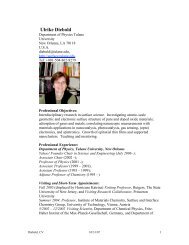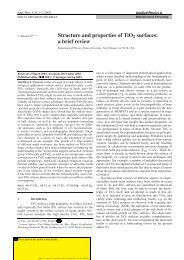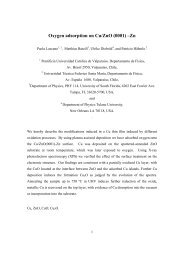The surface science of titanium dioxide - Niser
The surface science of titanium dioxide - Niser
The surface science of titanium dioxide - Niser
Create successful ePaper yourself
Turn your PDF publications into a flip-book with our unique Google optimized e-Paper software.
88 U. Diebold / Surface Science Reports 48 (2003) 53±229<br />
2.2.2. Reconstructions<br />
2.2.2.1. Reconstruction under reducing conditions: the structure(s) <strong>of</strong> the (1 2) phase. <strong>The</strong> most<br />
commonlyobserved reconstruction on TiO 2 (1 1 0) <strong>surface</strong>s has a (1 2) symmetry with a doubling <strong>of</strong><br />
the periodicityalong the ‰1 10Š direction. Various models have been suggested for this reconstruction and<br />
the most popular ones are depicted in Fig. 18 [113].<br />
A(1 2) LEED pattern was originallyobserved after high-temperature annealing <strong>of</strong> a reduced<br />
TiO 2 (1 1 0) sample in ultrahigh vacuum (UHV). Based on Ti:O AES ratios it was interpreted as<br />
alternate rows <strong>of</strong> bridging oxygen missing from the regular (1 1) <strong>surface</strong> (``missing-row model''<br />
[111], Fig. 18a). One <strong>of</strong> the ®rst atomicallyresolved STM results on this <strong>surface</strong> was also interpreted as<br />
missing bridging oxygen rows [114,158]; however, the Ti atoms underneath the missing oxygen atoms<br />
had to be shifted byhalf a unit cell in [0 0 1] direction to account for the observed image contrast. A<br />
structure with a (3 2) symmetry was reported in [159]. A model for this reconstruction was discussed<br />
where this symmetry is achieved by removing 1/3 or 2/3 <strong>of</strong> the oxygen in the bridging oxygen rows.<br />
However, such a reconstruction has not been reported byother groups.<br />
<strong>The</strong> simple missing row model for the (1 2) structure in Fig. 18a has been abandoned on the basis<br />
<strong>of</strong> more recent results. In STM the (1 2) reconstruction is commonlyobserved as a series <strong>of</strong> bright<br />
strings along the [0 0 1] direction [113,114,123,158,160±162], see Fig. 16. At low coverage, the strings<br />
grow preferentiallyout <strong>of</strong> the upper terrace onto the lower one (Fig. 16a) [123]. At ®rst, theyare<br />
scattered across the terraces with a minimum distance <strong>of</strong> 13 AÊ along the [0 0 1] direction. <strong>The</strong>yconsist<br />
<strong>of</strong> bright double strings (although the double-ridge structure is <strong>of</strong>ten not resolved), with a bright dot at<br />
the end. Antiphase boundaries are observed in high-resolution images <strong>of</strong> a fullydeveloped (1 2)-<br />
reconstructed <strong>surface</strong> [113]. Higher periodicities, i.e., a local (1 3) reconstruction, have also been<br />
observed [161,163,164]. In STM images the (1 2) strands generallyhave an apparent height smaller<br />
than a regular TiO 2 step edge <strong>of</strong> 3.2 AÊ , and are in registrywith the bright rows <strong>of</strong> the (1 1) substrate.<br />
Because most researchers report empty-state images and because these are dominated by the tunneling<br />
into mostlyTi3d-derived states (see Section 2.2.1.3), bright strands in line with bright substrate rows<br />
implythat the (1 2) strands are at the position <strong>of</strong> ®vefold coordinated Ti atoms and not at the bridging<br />
oxygen atoms. STM images <strong>of</strong> a simple missing row structure are expected to show a bright feature<br />
above the missing bridging oxygen row (provided the STM tip is a reasonable distance from the <strong>surface</strong><br />
[112]), inconsistent with the registryobserved experimentally. <strong>The</strong> rows can be removed bytunneling<br />
under `extreme conditions' (V s ˆ‡1:5 V,I ˆ 10 nA [113]). First-principles total-energycalculations<br />
show that the added Ti 2 O 3 model (discussed next) is energeticallyfavored [165] and that the missing<br />
row structure is energeticallyequivalent to a (2 1) structure (where everyother bridging oxygen is<br />
removed) [99]. For all these reasons, the missing-row reconstruction is no longer considered a viable<br />
model.<br />
Earlyon, Onishi et al. [122,123] suggested a quite different model. It consists <strong>of</strong> double rows <strong>of</strong> Ti<br />
cations in a distorted tetrahedral con®guration (Fig. 18b). <strong>The</strong> structure has Ti 2 O 3 stoichiometry, and<br />
the model is <strong>of</strong>ten called `added Ti 2 O 3 rows'. However, it needs to be emphasized that the structure<br />
does not resemble the one found in the corundum Ti 2 O 3 structure. Rather, the Ti cations reside in<br />
positions similar to interstitial sites in the rutile lattice [91]. Self-consistent total-energyand electronic<br />
structure calculation found that this added `Ti 2 O 3 ' row structure has a lower <strong>surface</strong> free energythan<br />
the missing row structure and that it is consistent with the contrast in STM [165]. Recent VASP<br />
calculations show that such strands can be added at low energycost [91], but also that manyother







